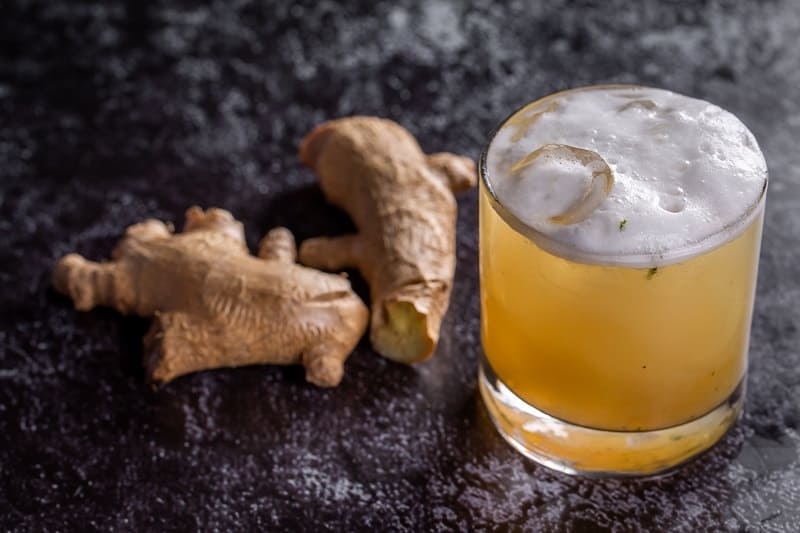The question of whether ginger beer contains alcohol taps into a broader conversation about the beverage’s origins, production methods, and its place in both history and contemporary culture. “Does Ginger Beer Have Alcohol?” is an article meticulously designed to address this query with depth and authority, crafted by experts steeped in the fields of food science, beverage history, and the evolving landscape of non-alcoholic and alcoholic drinks. This exploration goes beyond a simple yes or no answer, offering readers a comprehensive understanding of ginger beer’s unique characteristics, how it differs from ginger ale, and the various factors that determine its alcohol content.
Ginger beer, a beverage cherished for its spicy kick and refreshing taste, has a rich heritage that dates back centuries, originally brewed as an alcoholic drink. Today, it straddles the line between soft drinks and alcoholic beverages, with its alcohol content varying by brand and brewing method. This article delves into the fascinating process of fermentation that can give rise to alcohol in ginger beer, the legal definitions that categorize it, and how modern brands adapt to consumer preferences for both non-alcoholic and alcoholic versions.
Designed to enlighten and engage, “Does Ginger Beer Have Alcohol?” invites readers on a journey through time and taste. It addresses common misconceptions, provides clarity on labeling, and discusses the role of ginger beer in popular cocktails. Whether you’re a mixologist, a home brewer, or simply a curious consumer, this article is a treasure trove of information that promises to deepen your understanding and appreciation of ginger beer. So, let’s embark on this flavorful exploration together, uncovering the secrets behind ginger beer’s intriguing blend of tradition and innovation.
What Is Ginger Beer?

Ginger beer is a carbonated soft drink flavored primarily with ginger. It often contains other ingredients as well, like lemon, lime, honey or sugar to sweeten it. The “beer” designation comes from its traditional production process of being fermented, though most modern ginger beer is non-alcoholic.
Traditionally, ginger beer was made by fermenting a ginger root, sugar and water mixture with a ginger beer plant. This starter culture, also called a mother or bug, contains yeast and bacteria that cause the fermentation process. The end result was a naturally carbonated, mildly alcoholic brew.
These days, most ginger beer is made by adding ginger flavoring and carbonation to water, without fermentation. This makes it non-alcoholic while retaining its signature spicy zing. However, some specialty ginger beer is still made using the original fermented method.
The Alcohol Content in Ginger Beer
Ginger beer traditionally had alcohol content, with original versions containing about 11% alcohol. However, modern ginger beer is typically alcohol-free or contains very low alcohol levels, around 0.5% ABV. The fermentation process in traditional ginger beer production used to result in alcohol content, but today’s commercial ginger beer is often carbonated without fermentation, making it a soft drink with minimal to no alcohol content.
Ginger Beer vs. Ginger Ale: Distinguishing Factors
Ginger beer is often confused with ginger ale, but they are quite distinct. Here are some key differences:
- Flavor intensity – Ginger beer has a much stronger, more pronounced ginger bite. Ginger ale is milder in taste.
- Carbonation – Ginger beer tends to be less carbonated, with a thicker, more syrupy mouthfeel. Ginger ale has a lighter effervescence.
- Uses – Ginger beer is commonly used in cocktails. Ginger ale is more often consumed on its own or paired with meals.
- Color – Ginger beer is generally cloudier with a darker golden color. Ginger ale is clear and pale.
So in summary, ginger beer delivers a more robust ginger flavor, while ginger ale offers a delicate ginger kiss. Ginger beer also veers closer to a soda, while ginger ale is more like a sparkling water.
Cultural and Historical Significance of Ginger Beer
Ginger beer originated in England in the mid-1700s, though brewed ginger drinks existed long before then. Early ginger beers were homebrewed daily for personal consumption as a safer alternative to often tainted water.
Its popularity quickly spread through the British Empire as colonists brought the beverage abroad. For many cultures under historical British rule, local ginger beer traditions developed:
- Jamaica – strong “ginger beers” are still made with rum and lime juice added
- Nigeria – often flavored with cloves for a spicier kick
- India – masala ginger beer incorporates Indian spices
So while ginger beer originated in Britain, it was embraced and reinvented by cultures worldwide. It holds an important place in the food heritage of many former British colonies.
Health Benefits of Ginger
Ginger has long been prized for its medicinal properties. As a result, ginger beer can impart various health benefits:
- Anti-inflammatory – Compounds like gingerol in ginger have anti-inflammatory effects, helping relieve joint pain or sore muscles.
- Antioxidant – Ginger contains antioxidants like zingerone, supporting immune health and fighting cellular damage.
- Anti-nausea – Ginger has been shown to be effective against nausea related to motion sickness, chemotherapy, or morning sickness.
However, most ginger beer today contains high amounts of added sugar, which counteracts some of ginger’s benefits. But in moderation, ginger beer can still be part of an overall healthy diet.
Making Your Own Ginger Beer
Want to try your hand at brewing ginger beer at home? Here are two methods, one fermented and one not:
Traditional:
- Combine grated ginger, lemon juice, sugar and water in a sterilized jar.
- Add a ginger beer plant starter or brewer’s yeast to kickstart fermentation.
- Allow to ferment for 4-5 days. Strain and transfer to flip-top bottles.
- Let ferment 1-3 more days to carbonate before refrigerating.
Non-Alcoholic:
- Bring water, ginger, lemon and sugar to a boil, then remove from heat.
- Add yeast once cooled to jumpstart carbonation.
- Strain mixture after 8-12 hours and divide between bottles.
- Leave bottles to carbonate for 1-2 days before chilling.
The traditional method yields a stronger, spicier brew, while the non-alcoholic version offers cleaner ginger flavor. Feel free to tweak flavors to your taste by adding more ginger, citrus zest, honey or spices.
Nutritional Information and Dietary Considerations
A standard ginger beer (120ml) contains around:
- Calories: 90-130
- Total fat: 0g
- Sugars: 25-35g
- Sodium: 15-40mg
So ginger beer is high in sugar due to added cane sugar or sweeteners like honey or agave syrup. This gives ginger beer its sweet-spicy taste, but too much may be problematic for people with diabetes or metabolic concerns.
Ginger beer is generally considered gluten-free, though those with celiac disease should verify labels as some contain barley. It’s also vegan friendly.
Overall, ginger beer can be enjoyed in moderation as part of a balanced diet, but the high sugar content is something to be mindful of.
Varieties and Innovations in Ginger Beer
From classic brands to artisanal offerings, you can find many varieties of ginger beer on the market today:
Traditional
- Cock Brand – A spicy original since 1740, still made with a live ginger culture
- Fever Tree – Popular in Europe, made with blended gingers and natural ingredients
Flavored
- Rachel’s – Offerings like pineapple and blood orange ginger beer
- Square Mile – Microbrews like cayenne and pink peppercorn ginger beer
Alcoholic
- Crabbie’s – Fermented ginger beer made with ginger from Thailand and Malaysia
- Merchant’s Heart – Small batch ginger beers using yeast for light alcohol content
Innovations
- “Healthier” reduced sugar ginger beers using stevia and monk fruit
- Ginger-turmeric ginger beer with anti-inflammatory benefits
- Nitro ginger beer – Infused with nitrogen for a creamy, frothy texture
So whether you prefer bold and traditional or fruit-flavored and fizzy, there’s a ginger beer out there to suit any taste.
Serving Recommendations and Pairings
How should ginger beer be served and what foods or beverages complement it?
- On ice – Especially refreshing on a hot day
- With a lime wedge – Balances out the sweetness
- In cocktails – Adds a spicy kick to Moscow Mules or Dark and Stormys
- With rum/whiskey – For an extra boozy twist on the original
- With spicy cuisines – Pairs with Indian, Thai, Mexican dishes
- With seafood – Compliments shellfish like lobster or crab
- With gingerbread – Accents the shared ginger spice
Ginger beer can be enjoyed on its own, dressed up in cocktails or paired with meals. Its versatility makes it suitable for any occasion.
Regulatory Aspects and Consumer Labeling
Commercial ginger beer is subject to various regulations and labeling standards:
- In the U.S., ginger beer must state “non-alcoholic” clearly on packaging if it contains less than 0.5% ABV. Amounts over this threshold must have an alcohol content percentage.
- In the E.U., beverages with over 0.5% ABV cannot be labeled as “ginger beer” and must be classified as an alcoholic ginger beer drink.
- Carbonation levels, ingredients lists and nutritional information must also be included on the label according to local food safety laws.
- Labels that state “naturally brewed” must adhere to traditional methods using fermented ginger starter cultures.
Being aware of these regulations allows consumers to better understand what they are purchasing when they buy ginger beer. It enables them to make informed choices about ingredients, alcohol content and production methods.
Environmental Considerations in Production

More eco-friendly ginger beer production methods are on the rise:
- Locally sourced organic ginger reduces food miles and synthetic pesticide use.
- Some producers only use ginger peel to minimize food waste.
- Reusable swing-top bottles replace single-use glass or plastic bottles.
- Lower carbonation levels require less intensive production processes.
However, most mass-market ginger beer still generates significant waste from glass, plastic bottles, cane sugar farming, water use and transportation emissions. Ultimately, small-batch local ginger beers tend to have the lowest environmental impact. But all producers can continue improving their sustainability practices.
Future Trends and Consumer Preferences
Based on current trajectories, the ginger beer market will likely continue evolving in certain directions:
- Appeal to health-conscious consumers by reducing sugar content and experimenting with new natural sweeteners.
- More diversification of flavors through unique spice blends, fruit infusions, or even CBD and adaptogens.
- Continued growth of small-batch craft ginger beers focused on unique local sourcing and ingredients.
- Further expansion into Western markets as the beverage gains mainstream popularity outside its traditional regions.
Consumer interest in unique flavor experiences and perceived health benefits continues to drive ginger beer innovations. While staying rooted in its heritage, ginger beer is poised to keep transforming to meet shifting consumer demands in new markets worldwide.
Related: guinness alcohol content
Conclusion
Far more than just a mixer, ginger beer has a rich history and culture all its own. This lively beverage manages to balance potent ginger spice with refreshing sweetness and carbonation. Its popularity endures both for its distinctive flavor and associations with nostalgia, good health and vitality. With so many varieties now available, it’s easy to find a ginger beer that satisfies your personal tastes. From traditional homemade brews to inventive craft concoctions, ginger beer offers a multi-faceted experience in a bottle. So the next time you come across this intriguing brew, take a moment to savor its complex symphony of flavors.
More From Irish Setter Pub
- Heineken Alcohol Content Profile| All Thing About This
- How Much Guinness Alcohol Content Of? Learn The Answer Here

